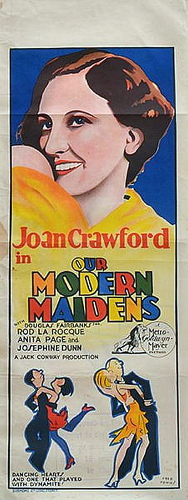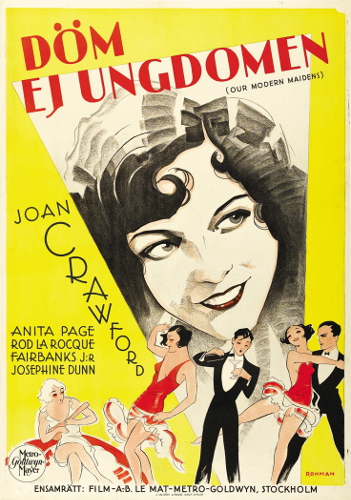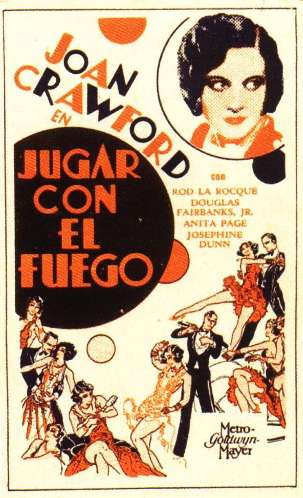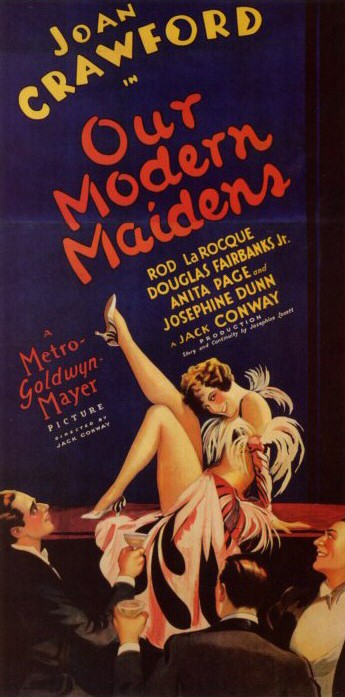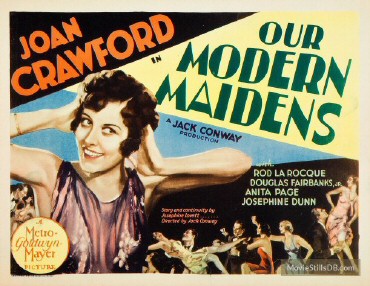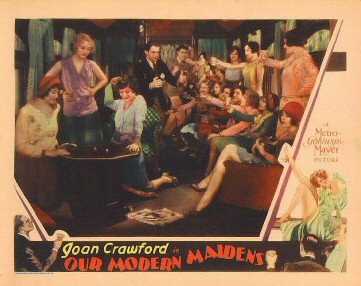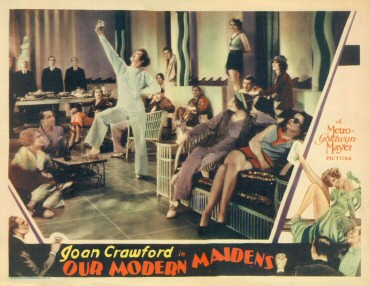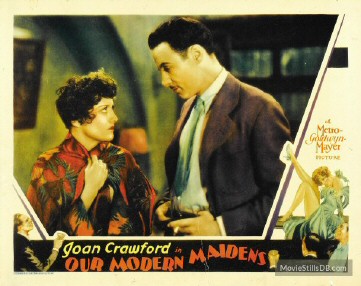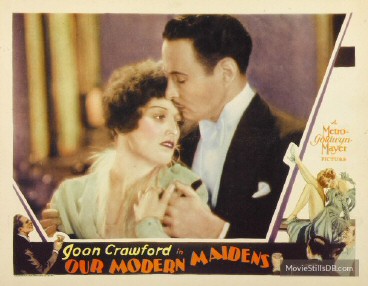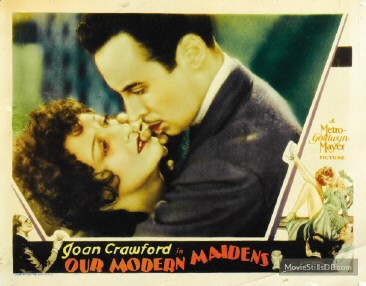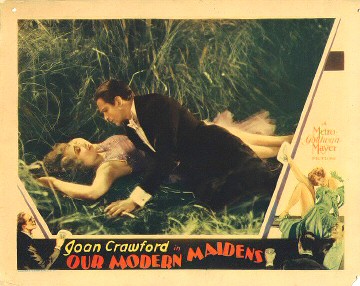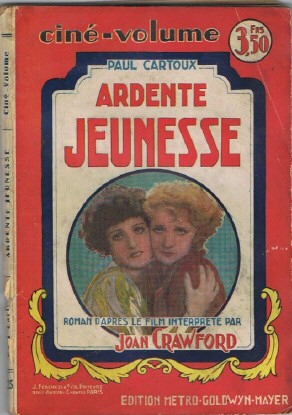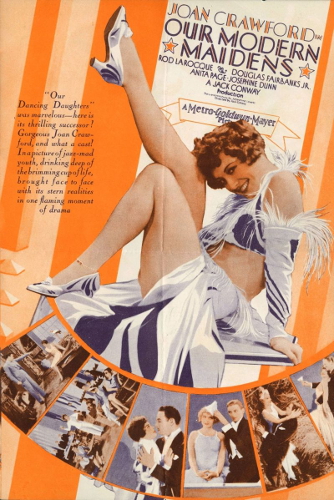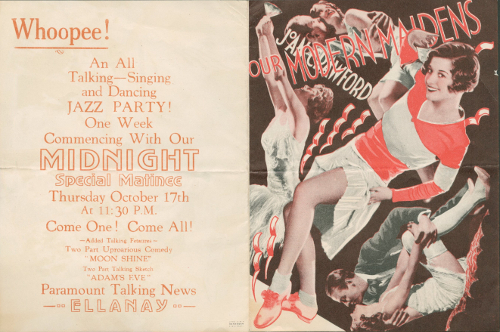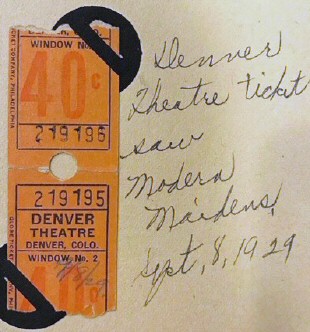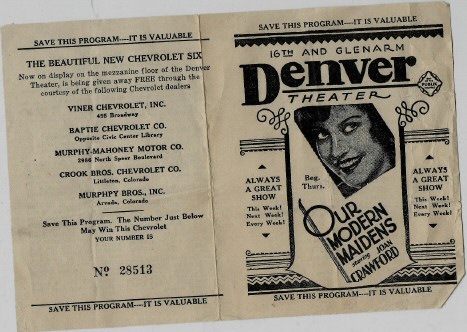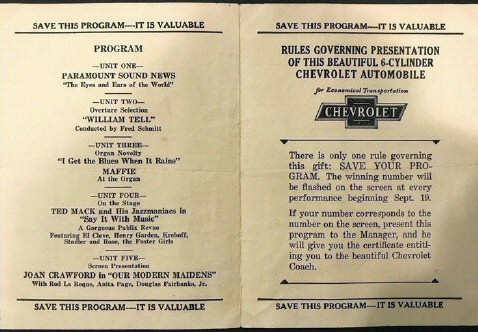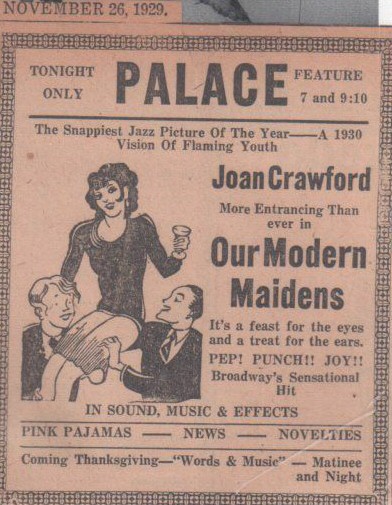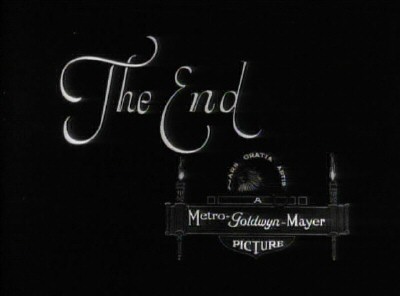|
 Tom C.
(July 2022) Tom C.
(July 2022)
Rating:
  -1/2 of 5
-1/2 of 5
“O, what a tangled web we weave when first we practice to deceive.” -- Walter Scott. Old Wally would have loved Our Modern Maidens (1929). How did Joanie---Billie, only child of uber-rich B. Bickering Brown---think her scheme was going to work?! Seduce diplomat Glenn “Dynamite”
Abbott (Rod La Rocque), get her beau Gil (Doug Jr.) his dream job, tell
Glenn to run along, live happily ever after in Paris with Gil? If
Dynamite is so influential, wouldn't he just quash Gil's diplomatic
career upon discovery of Billie’s duplicity?
Speaking
of future hubby #1: Doug Jr.’s highlight in this movie is the
impressions he does of Joan's past and future co-stars, Jack Gilbert (12 Miles Out and Four Walls) and John Barrymore (Grand Hotel),
respectively. His impression of his dad, Douglas Fairbanks (the “fair”
half of Hollywood’s first power couple, Pickfair), is the best of the
three in my opinion.
Rod
La Rocque is very good in this movie, transitioning from sophisticated
diplomat to lovesick puppy to jilted ex. This is not a surprise, as La
Rocque had been acting in films since the 19-teens. Anita Page more or
less reprises her role from Our Dancing Daughters, except this time Ms. Page plays a good girl who really is a good girl, but still falls in love with and steals Joan's man!
Among
minor players, Josephine Dunn as Ginger livens up the film with her
wisecracks and witticisms. (She alas had a short career, most notably as
one of Carole Lombard’s fellow gold diggers in 1930’s Safety in Numbers,
which I highly recommend for any fan of pre-code films.) Eddie Nugent
plays the same role he did in all of Joan's films---tuxedoed friend, wit
dispenser, bon vivant---all usually done with a drink in hand.
The
movie is directed by Jack Conway, whose claim to fame may be that he
was one of the very few people---along with Edmund Goulding---to direct
both great divas, JC and Gloria Swanson.
For the second time (first was in the lost Dream of Love,
1928), Joan is dressed by Adrian. And for one of the few times I can
recall in a film---or indeed anywhere---we see JC lounging around in
pants! Not a fan. Presumably this is before JC adopted her famous “I
never go outside unless I look like Joan Crawford the movie star. If you
want to see the girl next door, go next door” motto.
Joan’s hairdo throughout most of the movie seems a linear combination of her bob in Our Dancing Daughters and the frizzy do she sported in Rose-Marie,
both 1928. This was presumably before Sid Guilaroff took control of
Joan’s coiffure.
Sound was used in Our Modern Maidens,
but there is no synchronized dialogue. To be honest, it seems like MGM---which I read was among the last to adopt sound---was caught betwixt and
between. In places, there are almost too many dialogue cards; in others, not enough. The best use of sound is the music. For example, the
early party scene with Doug's aforementioned impressions is well done.
Everyone is having a good time in Cedric Gibbons' Art Deco fantasy land.
I love JC on the drums! She looks so vibrant and carefree. Given that
this film was released on the eve of the stock market crash of 1929, you
get a sense that the page is about to turn, not only on the hedonistic
days of the Jazz Age, but in Joan’s early career, from hotcha girl to
serious actress.
Honestly, this has never been my favorite Joan silent. Joan doesn’t evoke from me the same sympathy she did as Diana in OurDD.
This is Joan's last silent film, and I think the plot was the least of
MGM’s concerns. The studio must have just wanted to get JC on film with
new husband Doug Jr. and the plot be damned.
 Michael
Lia (May 2019) Michael
Lia (May 2019) Rating:
    of 5
of 5
Oh boy. Here it comes, and there it
all goes. Miss Crawford's last silent film, and the end of an era. A goodbye to
the art of silent films, and, dammit, a way of being in Hollywood.
Miss Crawford was on the rise and
this film, while not an acknowledged masterpiece after many other successes, would
propel her to new heights, a new home, a new husband, and more fans. With this
film, MGM head LB Mayer took advantage of the Cinderella story, his studio's
publicity, and Miss Crawford's marriage to the scion of Hollywood, Douglas
Fairbanks, Jr.
The movie provided Douglas, Jr., and
Joan the opportunity to showcase onscreen their real-life romance. The cast and
crew give us another fun-loving 1920's Wild Youth extravaganza with lots of
beverages (despite Prohibition). There is a bit of inserted musical soundtrack,
as in Our Dancing Daughters, but the
focus is still on the titles, not words. The movie also features Joan trying to
figure out her love life—love triangles are something she will be dealing with
in her next 60 films!
Director Jack Conway (Red-Headed Woman, A Tale of Two Cities,
and my favorite Libeled Lady) works
with producer Hunt Stromberg (who later produces The Women).
Besides the romantic pairing with
Douglas, Jr., Our Modern Maidens
features the great Rod La Rocque-- just his name alone is proof of the idol he once
was. Anita Page, also to ultimately fade away, is here also, still having
fun with other co-stars like Eddie Nugent and Josephine Dunn. The cameraman,
Joan-favorite Oliver T. Marsh, had a few daring scenes to film, like the
automobile race in the opening and having to keep up with Miss Crawford's
vivacity!
Just enjoy the film as a part of silent
film history.
 Stephanie
Jones
(September 2005) Stephanie
Jones
(September 2005)
Rating:
   of 5
of 5
Our
Modern Maidens, Joan's last silent film, isn't exactly a sequel to the previous
year's smash hit Our Dancing Daughters despite its parallel title, but
it does continue the adventures of the young, fast, rich set, anchored here
by Joan's "Billie," another modern wild-but-decent daughter. Like
OurDD, OurMM features wild parties, drinking, and dancing by jazz-baby Joan,
as well as some snappily risque (for the time) dialogue along the lines of "There's
something in my pocket...Dig for it" (um, that's an engagement ring that
Billie comes up with) and "Lunch is poured!"
This
movie, like OurDD, opens fast---in the first 30 minutes or so, the youthful
Moderns flirt, neck, race cars, and party hard and lavishly. Anita Page---the
wicked Ann from OurDD---is also on hand here as Billie's good-girl friend "Kentucky,"
who admires Billie but is also in love with Billie's fiance Gil. Gil is played
by Joan's real-life fiance Doug Fairbanks, Jr., in their only film together.
Fairbanks, whom I've never seen act before, is dazzlingly good-looking, charismatic,
and witty here: The highlight of his performance, and one of the highlights
of the film, comes at the party in the opening scenes, when he entertains the
crowd with a series of clever impressions of famous leading men: a grimacing
John Barrymore, a manically intense shoulder-rolling John Gilbert, and,
most fun of all, a version of his own swashbuckling dad Doug Fairbanks as Robin
Hood.
After
the jazz-hot first half-hour, the film settles into its plot: Billie and Gil
are secretly engaged, but Billie still dallies with the more mature and important
diplomat, well-played with restrained intensity by Rod LaRocque. Gil is jealous
and himself dallies with the innocent Kentucky, who's completely in love with
him. Who will end up with whom?!
But
the lightweight plot's not really the point here. The whole purpose of OurMM
is to again showcase (and cash in on) the spunky, stylish, and thoroughly modern
Joan as a Party Girl with a Heart of Gold. She doesn't disappoint. Whether jauntily
cutting loose on a drum-kit or dancing with bare midriff or nonchalantly shooting
craps and drinking on a train before noon, Joan is indeed "all that."
And a real actress, to boot. The early fun stuff is specifically for her teenaged
and collegiate fans of the time, but also check out her later scene with LaRocque
when he's semi-manhandling her and she's genuinely scared but not about
to show it, as well as her post-wedding scene when she must, without her new
groom, run the gantlet of a gossipy crowd. In each case, her character's "game
face" is securely on, but we viewers also get to see the struggle behind
it. Despite just a bit of eye-popping and lip-biting (early-Joan mannerisms
that turn up throughout the '30s and occasionally in her later films),
her character's inner battles with serious outward situations are done naturally
and interestingly---a preview of and prelude to her more dramatic roles
upcoming in the next few years of her career.
James
(March 2005)
Rating:
     of 5
of 5
I confess: I’ve fallen madly and hopelessly in love
with this movie! As a long-term Joan Crawford fan, an
art deco aficionado, and someone who’s been crazy
about the “Roaring ‘20s” since childhood, this film
hit all the right notes and had me grinning from
beginning to end. This is the most charming and
delightful movie I’ve seen in a long time, and I truly
can’t praise it enough.
In Our Modern Maidens, Joan plays an aptly named
character named “Billie," and the film parallels
reality to some extent by showcasing the young Joan
Crawford/Billie Cassin the way she was during the
1920s: happy, carefree, and dancing up a storm. It’s a
rare treat to see Joan like this, and she gives an
expressive, vivacious, and absolutely adorable
performance as a strong willed young flapper not
unlike herself. I really enjoyed seeing her this way,
and it was fun to spot what would later become
“Crawfordisms” long before her screen persona was
fully developed. The jaunty, "tip of the hat" wave she
gives (and later used to great effect as Sadie
Thompson in Rain) is just one example of this. She’s
confident and cheeky in this movie, and it’s a riot
watching her bang away on a drumset, and then perform
a sexy dance number in a revealing bra and skirt
outfit with her navel on full display {which was
pretty hot stuff in 1929).
Playing opposite Joan are Douglas Fairbanks, Jr., as
Gil, Anita Page as Kentucky, Josephine Dunn as Ginger,
and matinee idol Rod La Rocque (love that name!) as
Glenn, all of whom deliver strong performances. Anita
Page is a little “hammy," but she’s extremely cute
strumming her ukulele and mouthing
“boop-boop-bee-doop” while she plays. Josephine Dunn
portrays jaded and bitchy quite well, and she garners
some genuine belly laughs as a result. Rod La Rocque
plays it straight for the most part, and he’s
appropriately dashing and debonair as he woos Joan.
During a seduction scene, he grabs her hair and pulls
her head back for an aggressive, passionate kiss which
still manages to steam up the screen almost eighty
years later.
Doug Jr. is surprisingly funny in his role. He
demonstrates his talents as an impersonator in one
scene, brazenly imitating his father as Robin Hood by
leaping on top of a piano (I’ll bet he heard aboutthat later at Pickfair!). It’s fascinating to watch
Joan and her soon-to-be first husband acting together.
In one scene, Doug Jr. tells Joan: “There’s something
in my pocket...reach in and dig for it," and Joan’s
cheeky expression as she reaches in is priceless(double entendre all the way!). Their love for each
other is clearly evident in this film, and they make a
very attractive couple, epitomizing the "flaming
youth" of their generation.
Adrian’s costumes are sexy and glamorous, and if you
look very carefully it’s possible to detect tiny,
almost imperceptible shoulder pads in Joan’s wedding
dress (the seeds had been planted!). The authentic art
deco sets are beyond description and absolutely
stunning. The wedding scene in particular is straight
out of a Tamara De Lempicka painting, right down to
Joan carrying a bouquet of white calla lilies as she
marches down the aisle. Even the wedding cake is
shaped like a towering art deco skyscraper, and the
entire sequence is a love letter to the style and
design of the era.
Our Modern Maidens is a rare gem and a really fun
movie. In my opinion, Jack Conway (who directed some
of Gloria Swanson's best silents) skillfully and
deftly created a jazz age masterpiece. The mis-matched
lovers plot is simple and effective, the cast is
charming, the sets and costumes are pure eye candy,
and the film moves at a fast-paced clip, never lagging
once. I absolutely loved this movie...what a treat!
Memorable Lines
“Leave it to me! I’ll get you to Paris if I have to
start another war!” Billie to Gil.
“All together, children...what are our thoughts on
leaving school?” Billie to girls.
“Men! Men! Men! Men!! MEN!!” The girls' response.
“Lunch is poured!” Waiter on private railway car.
“She must have been in the Northwest Mounted...she
always gets her man!” Ginger.
“What do you think of a groomless honeymoon? Modern,
isn’t it? I’m just starting the fashion.” Billie.
“Do tell us...is this a modern moral...or just another
immoral modern?” Ginger to Billie.
“Do you think you’d know the difference, darling?”
Billie to Ginger.
|
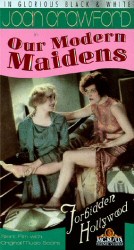
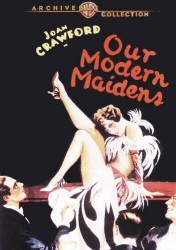 MGM
silent. 75 minutes.
MGM
silent. 75 minutes.
 Michael
Lia (May 2019)
Michael
Lia (May 2019) Stephanie
Jones
Stephanie
Jones